G. L. Pease
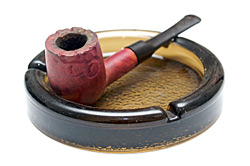 This edition marks the second anniversary of this column. Where has the time gone? I had no idea when I first proposed it that it would be so long-lived, and I hope it continues to bring as much enjoyment for those who read it as it does for me to write it. As long as the great questions keep coming, I’ll keep scribbling.
This edition marks the second anniversary of this column. Where has the time gone? I had no idea when I first proposed it that it would be so long-lived, and I hope it continues to bring as much enjoyment for those who read it as it does for me to write it. As long as the great questions keep coming, I’ll keep scribbling.
I’ve spent the morning with the weed-whacker, a device I think of not as a surgically precise electric scalpel, but more as a sort of brute-force mechanical machete, hacking and slashing at the jungle that I refer to only loosely as "the back yard." I’ve always envied those with carefully tended gardens, but have neither the patience nor the skills to create one myself. It’s a huge space, and an overwhelming one, so about as much as I can manage is a spring-time haircut, so at least the dogs have a place to run about.
As I settle in to write, physically spent, surveying the results of the hours-long toil in the sun-drenched fields, enjoying a bowl of some well aged leaf in a large briar, I’ll invite you to join me in a good smoke, and will try to offer some diverting words for your reading pleasure.
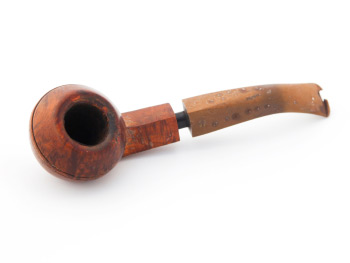 Buddy asks: I have a Savinelli straight stem pipe and an older Peterson dry system full bent pipe, both pipes need new stems but I cant find a pipe repair outlet. Could you recommend someone that repairs pipes?
Buddy asks: I have a Savinelli straight stem pipe and an older Peterson dry system full bent pipe, both pipes need new stems but I cant find a pipe repair outlet. Could you recommend someone that repairs pipes?
A: Sadly, good pipe repair people are rare, and becoming rarer. It’s a highly specialized trade requiring a great deal of skill, the proper equipment, an excellent eye, and the ability to solve sometimes challenging problems, and the pay isn’t very good. Recently, I’ve learned that a couple of good repairmen have left the business, and those I know of who do very fine work are so overwhelmed, they’re currently not taking anything new. As pipe smoking seems to be increasing in popularity, and more and more people are getting wonderful old pieces, often needing restoration and repair work, the workloads of the guys that are still doing it won’t be shrinking anytime soon. Of course, with some encouragement, new people may enter into this venerable trade to take up the slack, but it’ll take time before that does much good for any of us who need their services today.
Some repairmen do excellent, usable mouthpiece replacements, while others specialize in exact replicas for precious collectibles, which are much more difficult to produce, and therefore much more costly, so your requirements will dictate who you’ll entrust your briars to. A list of qualified repair professionals would be an excellent resource, but I don’t know of such a thing currently, and, the only guys whose work I have personal experience with are in the category of "Not taking new work," so I’m afraid I’m at a loss, but I’m sure the readership will have some excellent suggestions from their own experiences, and encourage them to offer their suggestions in the comment section below. (How’s that for a whole lot of words to say, "I don’t know?")
If you’re interested in one pipe maker’s perspective on the thankless job of doing repair work, and why he won’t do them, give Trever Talbert’s article, The Deadly Trap of Pipe Repair a read.
[Editor’s note: If you scroll near the bottom-middle of our Links Page, there are a few links for pipe repairs. These are links and not recommendations.]
Flip poses: I’ve been smoking a pipe for almost 6 months now and I absolutely love it! I started out smoking sweet tasting blends because as a new pipe smoker I liked the sweeter taste and that was actually all I knew of. As I began searching for other blends to try I came across your blends and was very intrigued by everything you have created. At the time I never heard of Latakia before so I ended up buying Blackpoint to see what Latakia is all about, having no idea of what it would taste like or smell like. When I got the tin and opened it up for the first time I was so surprised, almost shocked at the smell of it because it had such a smoky aroma to it, almost like smoked fish! At the time I have never smelled or tried anything like this before and I didn’t know what to make of it! So, I packed a bowl and gave it a smoke and I was confused and bewildered at the taste.
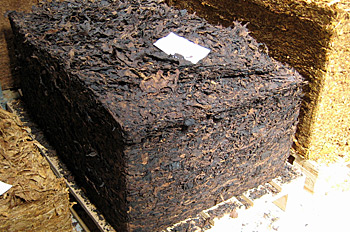 A: Latakia can have strange effects on those who aren’t expecting it. The smoke-curing creates a unique and unusual product. It’s impression on some, like my friend Marty Pulvers, who says that the only regret he has in his long career of pipe smoking is that he didn’t discover Latakia sooner, is one of those eye-opening, "Where have you been all my life?" things, while to others, its smoky intensity is met with somewhat less enthusiasm. Considering my own catalogue of blends, I’m sure it’s no secret what side of that fence I’m on.
A: Latakia can have strange effects on those who aren’t expecting it. The smoke-curing creates a unique and unusual product. It’s impression on some, like my friend Marty Pulvers, who says that the only regret he has in his long career of pipe smoking is that he didn’t discover Latakia sooner, is one of those eye-opening, "Where have you been all my life?" things, while to others, its smoky intensity is met with somewhat less enthusiasm. Considering my own catalogue of blends, I’m sure it’s no secret what side of that fence I’m on.
In very small quantities, Latakia plays a supporting role, adding depth and body to the flavor profile of the tobacco to which it is added. A little more, and it begins to sing with its own voice, adding some leathery, campfire notes that are sometimes more noticeable in the aroma of the smoke than in the taste. Still more, and a sort of sweetness can be found, and it begins to become more dominant. By the time we get in the range of 35-45%, or even higher, the other tobaccos in the mix had better be quite assertive, or the spice of the smoky stuff will just bully them until they run crying from the playground.
There are blends with well in excess of 50% Latakia, appealing to the hard-core, and there are even a couple blends on market with 70% or more. (Some people refer to these as "LatBombs," and they’re certainly not for the meek. If you’re not acclimated to the stuff, you’d be well advised to get your tongue a flak jacket before entering that territory.)
For me, the size of the pipe has much to do with the fullness of the mixture I want to fill it with. A large bore pot can bring out the best in more delicate formulae, but become quite overwhelming with a more intense one, but that palate bruising beast can be tamed into a gentle companion in a smaller chambered pipe.
I think everyone should at least try to get to know some of the excellent Latakia mixtures that are available. It may not be everyone’s cup of tea, but getting to know it can add some nice variety to the smoking repertoire.
Kevin wants to know: I suspect this question is a bit different than most you receive (and hopefully a refreshing change of pace), but it’s something I’ve often wanted to ask many blenders: How do you name your blends?
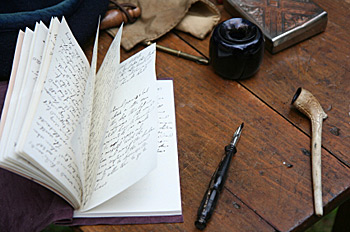 A: I have nearly as many answers as I have blends. I try to find names that will evoke a certain feeling, at least to me, that is appropriate to the blend, but there are other strategies behind some of the names, as well. For instance, the Classic Collection, with the exception of Blackpoint, is named after areas in or around London, and, alphabetically, they go from the fullest (Abingdon) to the lightest (Stratford). Abingdon, specifically, was named after Abingdon on Thames, the home of the legendary MG motorcar. For me, something about that wonderful, oily, intense smokiness of the tobacco recalled the wonderful smells of my old MGA, so it seemed fitting. For Stratford, I could certainly imagine Shakespeare puffing away on a clay full.
A: I have nearly as many answers as I have blends. I try to find names that will evoke a certain feeling, at least to me, that is appropriate to the blend, but there are other strategies behind some of the names, as well. For instance, the Classic Collection, with the exception of Blackpoint, is named after areas in or around London, and, alphabetically, they go from the fullest (Abingdon) to the lightest (Stratford). Abingdon, specifically, was named after Abingdon on Thames, the home of the legendary MG motorcar. For me, something about that wonderful, oily, intense smokiness of the tobacco recalled the wonderful smells of my old MGA, so it seemed fitting. For Stratford, I could certainly imagine Shakespeare puffing away on a clay full.
With each, I either try to find a name that is catchy, unique, evocative and memorable, or I just entrust my beloved late grandmother’s antique OUIJA board to work its magic for me. (My uncle, Llellewyn, actually was named by the board. It’s not a typo. Who knew OUIJA boards could be dyslexic?)
From Pete: We pipesmokers are often refered to as "Brothers (or Sisters) of the Briar". However, I am aware that there are many different materials commonly used to create tobacco pipes (olive wood, morta, meerschaum, corn cob, cherry wood, beech etc.). Could you shed any light on these other materials with regards to their relative smoking qualities, durability and any special care requirements. Have you had much experience with alternative pipe making materials? Do you have a favourite (aside from briar)?
A: I’ve smoked pipes made from a quite few alternative materials, including olive wood, the legendary "Mission Briar" pipes of WWII, made from Manzanita, a relative of the Erica arboria from which briar is mined, cherry, morta, and a few others. Each has its own unique characteristics. I’ve enjoyed the taste of cherrywood pipes, but they tend not to last very long. Strawberry wood seems very promising, from what I’ve seen, though I have yet to smoke one for myself, and morta is in a class of its own. Because of its apparently unique characteristics, briar has been the king of pipe woods for about 160 years, and to my mind, nothing yet has come close to accomplishing an effective coup d’etat. Personally, I enjoy exploring pipes made from other materials, but always find myself coming back to the tried and true. Maybe I’m just a traditionalist at heart.
Tonyy is concerned: Gregg, a very short while ago I purchased a pipe wipe made by Dunhill from a choice of two kinds at a particular website, the other I don’t remember who makes it but it is impregnated with carnuba wax and the Dunhill with silicone.
I used the Dunhill wipe on only a few older pipes like Everyman and a Ben Wade freehand from the seventies. Man the grain just exploded to life, they’re gorgeous! But then I got to thinking about the silicone and old briar wood that still gets smoked. Something suddenly doesn’t seem wise about this. What’s your take on that? Would the one with carnuba wax be more conducive to beautifying and protecting old briar that still gets smoked?
A: These products are formulated from waxes, either hydrocarbon or silicone based, dissolved in a carrier. When applied, the carrier evaporates, leaving the wax behind. At least, that’s the theory, and it seems to work.
My gut reaction is that silicone isn’t something we really want on our pipes. Though similar in behavior to hydrocarbon waxes in that they produce a durable, glossy finish, have predictable phase transitions from solid to liquid, and are protective against water, they also may be more permanent, and can be slippery feeling. Carnauba wax, on the other hand, provides a fairly durable finish, has a relatively high melting temperature, is protective, and can be buffed to a nice patina over time without reapplication. Further, carnauba isn’t toxic.
I like the way hard carnauba wax finishes wear over time, losing their high shine and developing a depth that is hard to describe. While my pipes are still warm, I simply buff them with a soft cloth, and their beauty is restored. When they begin to get very dull, a quick trip to the wheel with a block of hard carnauba does the trick. My feeling? Stay away from the silicone.
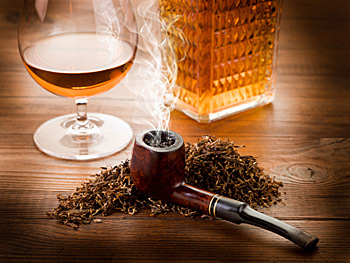 From Eric P: I recently tried some Sam Gawith Best Brown and really wasn’t satisfied with the flavor profile (my preference leans towards Union Square and Briar Fox) so I thought I would try to change it up a bit. I mixed up a solution of muscovado sugar, water and a bit of Pusser’s rum, let it soak for a couple of days and then let it air dry. I was attempting to give the tobacco a deeper molasses type note. I noticed very little change at all other than maybe making the tobacco smoke a little hotter due to the added sugar. I’ve tried similar experiments like this by immersing tobacco in 100% rum, drying and then not detecting any rum flavoring at all. Which brings me to a tobacco like Cornel & Diehl’s Blockade Runner which is soaked in rum. A lot of folks on Tobacco Reviews say a rum smell and taste predominates. But, being a rum drinker, Pusser’s blue label, Pusser’s 15 year (neat) and Appleton 12 year (neat), I can’t for the life of me taste or smell any rum. I say what the reviewers are smelling/tasting is the cavendish process in making this tobacco. So where did my experiments go wrong and what’s the deal with rum soaked tobacco?
From Eric P: I recently tried some Sam Gawith Best Brown and really wasn’t satisfied with the flavor profile (my preference leans towards Union Square and Briar Fox) so I thought I would try to change it up a bit. I mixed up a solution of muscovado sugar, water and a bit of Pusser’s rum, let it soak for a couple of days and then let it air dry. I was attempting to give the tobacco a deeper molasses type note. I noticed very little change at all other than maybe making the tobacco smoke a little hotter due to the added sugar. I’ve tried similar experiments like this by immersing tobacco in 100% rum, drying and then not detecting any rum flavoring at all. Which brings me to a tobacco like Cornel & Diehl’s Blockade Runner which is soaked in rum. A lot of folks on Tobacco Reviews say a rum smell and taste predominates. But, being a rum drinker, Pusser’s blue label, Pusser’s 15 year (neat) and Appleton 12 year (neat), I can’t for the life of me taste or smell any rum. I say what the reviewers are smelling/tasting is the cavendish process in making this tobacco. So where did my experiments go wrong and what’s the deal with rum soaked tobacco?
A: I think you might be going too far with the sauce; this is a case where less can be more. By soaking the tobacco, and then evaporating it to bring the moisture content back down, you’re losing not only alcohol and water, but also many of the volatiles that make rum what it is.
When you’re sipping your rum, what your actually experiencing is more the result of the aromas than the taste itself. (I’ll be discussing this in slightly more depth in an upcoming Out of the Ashes column.) As the liquid is warmed on the palate, volatile components are delivered to the olfactory sense through the retro-nasal passages at the back of the tongue. It’s these volatiles that are responsible for much of the difference between drinking rum and drinking vodka, which is closer to pure ethanol. If you leave a glass of rum sitting out for a few days, it’ll still smell like rum, but not nearly as intensely, and the taste will be similarly muted.
So, instead of soaking the tobacco, try infusing it. Put it in a glass jar with a cotton ball soaked with a little rum, seal it up, and let it sit for a few days. You just might find more of what you’re looking for.
Mark from the UK asks: As a British reader of your column I was pleased to see that some of your blends are now available from a retailer here in the UK. Assuming they go well, will you be increasing the selection available, or does the cost of shipping & tax mean it will always be a small market?
A: Part of that is up to you and the rest of their customers. I worked closely with them to develop a good initial product offering, with the notion that over time, the available blends would be broadened. There’s really no reason, other than economics, that they can’t stock the full range, but that will only happen if demand drives it.
The costs of getting the tins into the UK are high. First is the high cost of shipping. Unless we’re shipping over a very large quantity, it goes via air freight, which is much more spendy than sending by ship. Then, there are the extortionate taxes due upon the tobacco’s arrival in the country. Finally, there are packaging requirements that must be met. By the time it’s all totted up, it’s actually a wonder they can put it on the shelves for such a low price! (And, really, it’s not that much more than other premium brands, when you consider the fact that my 2oz tins contain approximately 13% more tobacco than the 50g of the other brands.)
So, the best way to ensure a wider selection is to give them your patronage, and make your specific requests. Believe me, no one would like to see a wider selection of my products on the shelves of UK tobacconists more than I.
That’s it for this month’s. Keep those cards and letters coming!
-glp
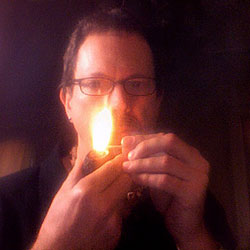 Since 1999, Gregory L. Pease has been the principal alchemist behind the blends of G.L. Pease Artisanal Tobaccos. He’s been a passionate pipeman since his university days, having cut his pipe teeth at the now extinct Drucquer & Sons Tobacconist in Berkeley, California. Greg is also author of The Briar & Leaf Chronicles, a photographer, recovering computer scientist, sometimes chef, and creator of The Epicure’s Asylum. See our interview with G. L. Pease here. |
















My favorite was the last question. I would have done the same thing as Eric. I would have never known to try infusioning it, and wouldn’t know how to do it.
It’s actually quite amazing that this column has had new material every month for two years straight.
–
I think demonstrates how unique and special our hobby is.
Another great addition, thanks Greg. It doesn’t surprise me that even after 2 years there are still plenty of questions that are fresh and interesting. There are so many aspects to this hobby that do continue to change, so interesting questions should not be an issue to continue this column for years to come.
Thanks for two years of terrific content. I learn something new from nearly every submission (I didn’t know you own (owned?) and MGA, a fine classic Brit. Now, realizing the connection, I’ll have to try some Abingdon!
Al, a few classic roadsters have been through my hands. I’ve still got a 68 Triumph Spitfire Mk3 waiting for the time and the extra money to finish up. One of these days…
.
Glad you’re enjoying the feature, and thanks to all for the encouragement. Keep those cards and letters coming, and I’ll keep writing. (My Out of the Ashes column has been going even longer.)
.
-glp
Greg, congratulations on the anniversary & thanks for all the answers.
Regarding Buddy’s question another route for getting a pipe repaired is the Danish Pipe Shop ( on their website look under ‘Information” on the grey bar across the top of their “Front”, ie home, ). I have not used this service but have found them to provide an efficient, helpful and friendly service while buying pipes, accessories and tobacco (indeed they are one of the sponsors -bless them all – of this magazine!).
If Greg sounds just a little defensive about the price of his tobaccos in the UK he should not be. Even the relatively limited current range is easily the best selection in the UK, certainly in terms of quality but also in variety of genres covered. The service offered by Gauntleys is second to none and includes a re-packaging required by UK law (on all tins sold over here we are required to get lurid pictures and warnings that have a very tenuous connection with pipe tobacco). In general the GLP price is only about ten per cent above other tinned (ten years ago I would have termed it quality) tobacco and is less than buying from the cheapest source in the USA (buy ten or so 8 ounce tins to get the discount and to absorb the fixed cost of freight and including all costs your $31 dollar tin finally costs about $90 and about $53 has gone on UK tax).
However, thats all relativistic and subjective (and true) but in a way irrelevant. In straight cash terms (even without corrections for short or metric measure) the most expensive tin on the UK market does not carry GLP’s much admired insignia because it is a Davidoff tin – their Medallions in fact costs £17.40 for 50 grams (that is about 30 bucks for 2 ounces) on the only site that I can find quoting a firm price for it. So, yes, GLP tobaccos are less expensive than we have a right to expect and their introduction is the brightest occurrence on the UK scene for years.
Thanks again Greg.
Ed T